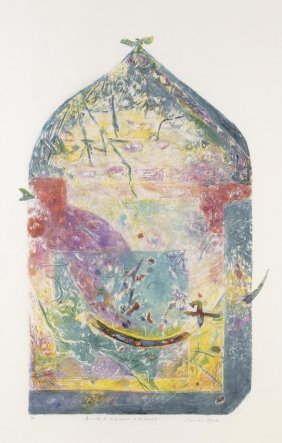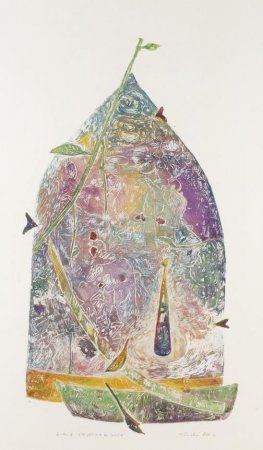
SUMIKO OKUBO from Tokyo
PRINTS
SCULPTURE
MIXED MEDIA ON PAPER
STUDIO SIENKO GALLERY
15 July - 18 September 2014
open Mon-Fri 11-6.30 sat 11-4pm
57a Lant Street , London SE1 1QN
Borough Tube 1 min
studiosienko@waterloowine.co.uk
0044 (0)20 7403 1353
Press Release
I am pleased to present a highly accomplished artist trying to create the beauty with
her enormous sensitivity and love of nature.
SUMIKO OKUBO
- Highly Acclaimed Printmaker from Tokyo –
-
Sumiko Okubo's work is widely published and exhibited in Japan and abroad. She is
a Director of the Japanese Art Society (Shun-yokai) established in 1922 with over 600
members.
Initially trained in Tokyo she also studied at the Central School of Art and Design with
Norman Ackroyd (RA) and Chris Orr (RA). While living in London she exhibited at the
Royal Academy and Concurs Triennial. She appeared on BBC television arts
programs and in the review of “the artist”. She has regularly exhibited her prints and
drawings (collectively called “A Poem of Nature”) in a range of Japanese, International
and UK galleries.
Since returning to Japan she has established herself as a major influence in Japanese
printmaking. Her work is inspired by the natural world combined with a deep sense of
the spiritual.
However her prints are unique in that her traditional Japanese style is imbued with
the western influences she absorbed during her time in London, all this beautiful work
produced by woodblock and etching.
As the noted Tokyo Art Critic Kensuke Tsukuda has written of her:
"The modern print techniques and influences she absorbed in London blend perfectly
with the metaphysical world and the traditional sense of beauty so important in
Japanese Art. It is a lyrical world derived from the luminous and misty style of the
Korin School".
Do not miss this exhibition.

Sumiko Okubo's Profile
Born in Tokyo, Japan, Graduated Women's College of Fine Arts (Tokyo), Worked as a Graphic Designer
1981-'87 Lived in England (Richmond),'81-83 studied at Sir John Cass College, Morley College /studied under Terry Greaves,
Norman Ackroyd, Chris Orr
1986 Completed Central Saint Martins College of Art & Design S.A.S. Printmaking (London)
Solo and main exhibitions
1984-'11 The Royal Academy Summer Exhibition,'85 The watercolor work was introduced and interviewed by BBC TV London
Prints & Printmakers from the Royal Academy, '84 Contemporary Art Exhibition (Aberystwyth art Center, Wales)
1985-'95 Artist Prints at the Royal Festival Hall (Print Maker's Council, London), Contemporary Art collection (Gallery Regatta, Surrey)
1986 Royal Society of Painter Etcher Engraver (Bankside Gallery, London) . Portfolio Members Exhibition of the Kew Studio (Smith's
Gallery, London), Hunting Art Prize(Mole Gallery, London), 4 Artists (Ice House Gallery, London), London Institute Selection of
Work ( National Theatre London)
1987 British Modern Prints Exhibition (CCAC Design Center Gallery, San Francisco), Prints & Ceramics Selection (Wandle Gallery,
Surrey)
1988-'06 Shunyokai Art Society Exhibition '92,'94,'95 Scholarship Prize '98 Shikanosuke Oka Prize (Tokyo Metropolitan Museum)
2007-'14
Shunyokai Art Society Exhibition (The National Art Center, Tokyo)
1989 US.UK Print Connection (Barbican Centre, London, New York)
1990 Solo Exhibition (Tokorozawa Seibu Department Store), '90-'14 CWAJ Print Show (Tokyo American Club)
1991,'93,'95 Solo Exhibition (Tokyo American Club Genkan Gallery), International Prints Selection (Pacific Art Gallery, Chicago/Miami)
1992-'05 Exhibitions held by Printmaker's Council (Concourse Gallery, Curwen Gallery, Eastleigh Museum, England, Germany)
1993 Solo Exhibition (Craft Gallery, Ketsuzan, Higashiyamato), Modern Elected Print Exhibition, Anglo German Exhibition (Concourse Gallery,
London, and Germany)
1994,'97,'00 Krakow International Print Triennial (Galerie BWA/Palac Sztuki, Poland)
1996 Basel Modern Art Exhibition-7 Japanische Grafik (Galeria Pierre Rippstein, Switzerland)
1998 '01,'04 Solo Exhibition (YOSEIDO GALLERY, Tokyo), The Works Show (The Suan Dusit Art Gallery, Bangkok), Aomori Print Grand Prix
Competition(Aomori City Museum Hall, Japan),
1999 Japan Contemporary Art Exhibition (The ChianMai University Art Museum, Thailand), '01KanaeYamamoto Print Grand Prix Competition
(Ueda City Museum, Japan)
2000 Vietnam-Thailand-Japan Modern Art Exhibition (Funabashi City Gallery, Tokyo), JDA Workshop & Installation (Park Tower,
Tokyo), Contemporary Japanese Art Exhibition (ART BOX GALLERY, Ginza), Fan Exhibition (Gallery Anri, Nagoya)
Venus: A Centenary Exhibition (Mitsukoshi Department Gallery, Tokyo)
2001 Facon Japon (La Galerie, France), Konoha Gallery Selection of Prints (Galerie Grand Paris, France/Konoka Gallery,Tokyo)
2002,'05 Solo Exhibition (GALLERY UESTO, Ginza), (Gallery Artpit, Kiryu,Japan)
2003 Shunyo ChianMai University Exhibition (The ChianMai University Art Museum, Thailand),
2004 4Th Contemporary Artists Exhibition from Japan (Zainul Gallery, Bangladesh, organized by Chuwa Gallery, Tokyo)
2004,'05 New Prints Exhibition (Gallery Rutan, Tokyo)
2005 MusiSocal images (Gallery Ichimainoe, Tokyo), Asahi A exhibition (Asahi Art Gallery, Tokyo), 5 Personalities (Ginza Towa Gallery,
Tokyo),
2006 Solo Exhibition (ART BOX GALLERY, Tokyo), GARDEN (Gallery Olive Eye, Tokyo), ART GARDEN (Shinjuku Takashimaya
Department Gallery, Tokyo) ,
------Sumiko Okubo's Art Works "A Season of Poems" published by the ART BOX GALLERY-----
2007 Solo Exhibition (Gallery Olive Eye, Tokyo)
2008 Solo Exhibition (STUDIO SIENKO GALLERY, London),(GINZA TOWA GALLERY,Tokyo)
2009 Solo Exhibition (Gallery So, Kanazawa-city,Japan) (Gallery Olive Eye, Tokyo), GardenⅡ
2009/2010 HORSE Christmas/New Year Group Show(STUDIO SIENKO GALLERY, London)
2010 Solo Exhibition (Riverside Gallery, London), Olive eye Exhibition (Gallery Ichimainoe), The 4th Asia International Art Exhibition
(Seoul)
2011 Solo Exhibition (Gallery So, Kanzawa-city, Japan),(Gallery Ichimainoe, Tokyo),
2012 Solo Exhibition (Numazu-shi Syouji Museum, Numazu-city, Japan) Monmusee,( Gallery Parcimon, Yamanashi-city, Japan)
Group Exhibition ARTIST( STUDIO SIENKO GALLERY, London),(Four Seasons/Three Artist ,Daimaru Art Gallery)
2013 Solo Exhibition(Gallery Ichimainoe,Tokyo) (Gallery Benitsubaki- Soleile,Kyoto-city,Japan), Best Selection
2013(TokyoMetropolitan Art Museum,Tokyo,Japan),Group Exhibition(Symbolism in Abstraction,STUDIO SIENKO
GALLERY,London)
2014 Solo Exhibition (GallerySo,Kanazawa-city,Japan),(GalleryBenitsubaki-Soleile Kyoto-city,Japan),(STUDIO SIENKO
GALLERY,London)
Many other group and solo exhibitions
Collections: British Museum, Central Saint Martins College of Art & Design (London), Ogilvy & Mather Advertising (New York)
The ChianMai University Art Museum (Thailand), Imabari-city Yoshiumi Cultural Center( Imabari, Japan)
Numazu-shi Syouji Museum(Numazu-city,Japan)
Occupation:Artist/Printmaker, the Director of the Shunyokai Art Society, the Supervisor of the Int’l Children’s Painting Competition
of the Environment(UNEP,FGPE), Lecturer at the several art societies
(Elected as the Director of the printmaking Dept. of the Shunyokai Art Society for 2009-2014)
Member of: The Shunyokai Art Society, The Japan Artists' Association, British Print Makers Council, JDA Designers Association
Homepage: http://homepage1.nifty.com/sumiko_central/


*A Temptation to the Forest Ⅱ, ed.13,
Woodblock, Etching, collagraph,
76x45cm, 2014
* A Temptation to the Forest III, ed.12,
Woodblock, Ething, collagraph,
82x45cm, 2014
A POEM OF THE HARVEST – SUMIKO OKUBO EXHIBITION
That the East has a spiritual dimension lost in the West has long been an important impetus for the crossing of cultural and religious
boundaries. That the extension of the boundaries of one’s culture can lead to more profound engagement creatively has been amply
demonstrated in the field of Art History. The impact of Japanese prints on European artistic sensibilities in the mid-19th century has been
well documented. Without re-rehearsing the importance of the impact of Japanese coloured woodcuts on mid-19th century European art’s
state of impasse and subsequent development (except when relevant) I would like to offer some reflections on the work of a present day
Japanese print maker, Sumiko Okubo. Her work embraces both Eastern and Western artistic cultures and is being exhibited at the
Riverside Gallery, Old Town Hall, Richmond from 17th July to 18th September 2010.
Sumiko Okubo was born in Tokyo, Japan, and after graduating from the Women’s College of Fine Arts (Tokyo) worked as a graphic
designer. From 1981 to 1987 she lived in London and during this time she continued her studies at Sir John Cass College, Morely
College (studying under Terry Greaves, Norman Ackroyd and Chris Orr). She completed her studies in 1986 at Central Saint Martins
College of Art & Design S.A.S. Printmaking (London). During this time her work was exhibited in both solo and main exhibitions.
Following her return to Japan, her work has continued to be exhibited both in Japan and throughout Europe to the present day. She was
elected as Director of the Printmaking Department of Shunyokai Art Society for 2009-10. She is a member also of the Japanese Artists
Association, International Artists Association, the British Print Makers Council and JDA Designers Association.
As her work demonstrates, she draws on the cultural heritage of both East and West; her work exemplifies mutual enrichment whilst at the
same time developing her awareness of the differences that exist between them. The essence of her artistic endeavour is to explore the
role of nature in her personal creative existence. For the East, nature has always been an integral part of the culture, religion and life of
man. As J. Hillier has noted, perhaps no nation has given expression to the worship of the beauties of nature more than Japan. It runs
reverentially through their art and literature and daily life. Certain birds and animals are venerated; pilgrimages are made to greet the full
moon, or to see cherry trees in blossom in Spring and red leaves of maples in Autumn. Mt. Fuji is deified. In the West, nature needed
to be tamed. Animals, plants and everything within it has been and largely continues to be seen as distinct from humankind. The
Western tradition of painting pursued a perfection in literal representation though often imbued with symbolic significance. And it was
at this point that Japanese influence made its most impact. The foundations of this literal, illusionistic representation were rent and the
creation of a new visual reality became a possibility for the West.
Following on from mid-19th century European Art’s initial imitation of individual motif and style, the implication of Japanese Art for the
creative transformation of Western Art came to occupy the thought of several highly individual artists who in turn would revolutionise
visual reality in 20th century art and beyond. In 1912, Frank Lloyd Wright gave voice to his seriously considered meditation on the
significance of the Japanese Print. Discussing the Japanese artist’s response to Nature, he emphasised that he was using the word Nature
in the Japanese sense – that is, not as an outward aspect which strikes the eye as a visual image, but as the inner harmony (the organic
form), which penetrates the outward form and is its determining character. He came to the conclusion that “the Japanese artist was the
one who was able to get to the hidden core of reality. The unseen is visible to him”.
A reverberation of Wright’s insightful summation was sounded in one of 20th century’s Western art’s most important dictums by Paul
Klee – “Art does not reproduce the visible. It makes visible”. An accomplished musician, he had chosen to become a visual artist
instead of a professional musician but music always remained an integral part of his daily and creative life. One of the truly great and
innovative European artists of the 20th century, Paul Klee’s artistic aim was the creation of colour polyphony in his works. His insight
into music enabled him to establish its principles for the art of painting. It was in Africa that he discovered colour, during a journey to
Tunisia in 1914. In his diary he wrote: “colour possesses me, there is no need to try to grasp it. It possesses me for ever, I
know…Colour and I we are one being”. In his Tunisian watercolours he captures the landscapes and gardens, the towns in small squares,
rectangles and triangles of vibrant and translucent colour. Flat colour rectangular theme became the most important component in his
work. He created pictorial space by overlapping and intersecting rectilinear colour planes but this did not allow independent colour
themes to be combined within the overlapping plane format. Klee realised that what he needed was to create a planar colour-space layer
that would be more unified and at the same time more transparent. So he devised his so called ‘pointillism’; he had used coloured dots to
achieve effects of space and colour in earlier works, e.g. ‘On a motif from Hammamet’. However, in 1930, he started to use colour dots
to lay transparent screens across entire paintings. At last he was able to develop separate colour themes in the same picture – one theme
in the ground and one in the frontal plane: “Duality treated as Unity”.
To engage with the works of Sumiko Okubo on exhibition at the Riverside Gallery, Richmond, is to experience the same overwhelming
sense of beauty of colour and composition that we respond to in Klee. They share a colour sensibility that is subtle, delicate and musical
in tone, and her work embraces many of the pictorial innovations of Klee. Sumiko’s ‘A Harvest iv’ (2002) and ‘Garden’ (2005) can be
compared with Klee’s ‘Chorale and Landscape’ (1921) and his ‘Growth in an old garden’ (1919). In both ‘Harvest iv’ and ‘Chorale and
Landscape’ colour conveys the season in non-linear colour rectangles that at the same time convey seasonal surface and depth. For both
artists, trees are representative of the roots of life and personal and creative human identity. Both artists here identify with Eastern
thought – whilst for the West the Harvest is an annually specified time in man’s life for rejoicing in the gathered fruits of the earth.
Similarly, Klee’s ‘Growth in an old Garden’ and Sumiko’s ‘Garden’ have more kinship with each other than with the conventional
connection between the garden of urban civilisation and nature. Neither of these two works revere nature as the revelation of a divine
spirit of creation but identify with it – man is not distinct from nature.
From the beginning of time, mountains for the Japanese were sacred sites, the summits of mountains were sites for shrines and later
temples. Old belief held that in Spring mountain gods became gods of the fields and came to protect the crops, returning to the mountains
after harvest. Mountains were thus a source of life and were to be venerated. The veneration still accorded Mt. Fuji is of a significance
not given to western experience. Many of Paul Klee’s paintings reveal a shared reverent affinity for mountains and trees. His
‘Mountains in Winter’ (1925) is sensitively evocative of Far Eastern landscape painting. His homage is acknowledged by his inscribing
faux Oriental calligraphy along the lower right margin. There is no denying the beauty of his depiction. A further interest of this work
is his deployment of atomizer spraying technique. By varying the density of the spray the frosted white of the snow laid over the dark
underpainting of the mountains conveys the hallucinatory chill stillness of moonlight on mountain snow. Below and in front of the softly
vibrating purple pulse of the mountain stands a fragile fan of a pine tree.
Sumiko’s ‘Mountain in Red’ (2004), unlike Klee or Hokusai previously in his depictions of Mt. Fuji, is not presented as a dominant peak
or summit. Instead of the muted misty ‘oriental’ delicacy of the Klee, Sumiko represents the mountain as the source of life through a rich
polyphony of colour and mixed media technique. The vibrant red, green, and gold convey the richness of nature in seasonal cycle. The
softly defined drape of purple recalls the poet Basho’s likening of profusion of purple wisteria draped over an Inn’s door to a traveller.
The stark snow whiteness of the almost spectral fragility of the trees is rooted in the rich red of the mountain – the source of renewal.
In this work we have the essence of the cycle of seasonal change. Her work is rooted in Japanese cultural response to Nature. At the
same time we see her draw on the cultural heritage of the West. Her responses and affinities interestingly are primarily with those artists
whose art in turn had been affected by the East. Hence, Paul Klee like whom she in her own unique way has created her own pictorial
colour polyphony whereby to explore the role of nature in her artistic existence. Like Klee, she employs a variety of new techniques in
her work and has introduced into her compositional vocabulary one of his pictorial devices the screen of dots translucent gauze. Many
titles of her works include musical references that so wonderfully resonate the colour orchestration of her compositions. Another artist to
whom she has been drawn and who has had an influence on her work is Helene Frankenthaler. A major inspiration for Frankenthaler’s
work has been nature and it was during a summer stay in Nova Scotia in 1952 that she produced a seminal work ‘Mountains and the Sea’.
The imagery though abstracted was still present in the peaks of the mountains placed in contrast to the horizontal ocean. The main
interest for Sumiko of this and subsequent works by Frankenthaler lay in the techniques employed. Instead of painting on top of an
already prepared canvas she poured paint over an un-primed canvas surface allowing the colour to soak into the canvas support to create
its own shape and edge. This process of staining the canvas with paint rather than making marks on its surface became the hallmark of
her style and the practice which came to be called colourfield painting. While areas were left unpainted leaving even the artist herself to
question, “Is it finished? Is it a complete picture?”. Drawing and staining with colour was a technique that appealed to Sumiko who
does not submit to the theory that as a print maker the aim of her work should be to produce a matt all inclusive smooth finished work
with nothing left to chance. She leaves white spaces of paper in her work that she refers to as “compositional air”. She leaves space for
interaction between the maker and the receiver as she herself says, “80% is my work and 20% is the input of the viewer of my vision”.
Given the traditional Japanese kinship between drawing and writing, reflecting on the title of the exhibition of Sumiko’s work at
Richmond might have some relevance to a viewer’s receptivity and appreciation of the works on view. Implicit in Western culture’s
concept, understanding and experience of the Harvest is the annual ritual of the Harvest Festival. Church and community join together to
rejoice in the blessing of the fruit of the earth, the fruit of man’s labour. The harvest’s cornucopia occupies a specific moment in the
Western calendar. In Sumiko’s pictorial poems The Harvest is embraced in nature’s arms in an Eastern way.
On entering the Gallery, one is so drawn to the images suspended on the spaces of the walls that one may plead forgiveness for not
pausing for some moments with her bronze objet d’art sculpture ‘Time to Revive II’ (2009), a portrait of the artist revived, revitalised by
her contact with plant life, with the earth, with a bees’ nest. One of the first works encountered is ‘A Gate to the Forest’ (2010). The
forest is in transitional stages of seasonal foliage garment change. The gate to the forest is the door of the mind, of memory through
which we filter the encounter. Gossamer-like curtains of colour are embossed across the imaged forest. Shades of Klee weave in and
out of this forest scene. ‘Summer Joy’ (2008) recalls Frankenthaler’s ‘Blue Territory’ (1955) in the way Sumiko in this work evokes the
coloured essence of a summer remembered. With ‘Crop II’ (2009) and ‘A Passage of Dream’ (2009), the boats, sea, and water, important
to Sumiko in her early English etchings, return us to the maritime livelihood of Japan. The seasons are caught in the sea nets and the
cranes fly overhead. ‘A Sound of Spring’ (2009) is almost Turneresque in colour but it is through Sumiko’s tonal cords that we hear the
sound of birds in flight, their wings, their cries of joy and sorrow. What lies for them beyond the horizon? ‘Waiting for the Season’
(2005) invites us to be the man, the woman, to sit at either end of the simple yet elegant bench to gaze into the future. Faintly, distantly
discernible, it is the man-made growth of buildings. Leaves like birds hover and float across the scene.
‘Harvest’ as a theme for individual works and ‘Poem for the Harvest’ for series of works clearly indicate a significant pre-occupation for
Sumiko’s personal and creative response and engagement with nature. The most recent series 2009 employ all the elements of her visual
vocabulary in compositions which return her to her Japanese roots through cultural references and through return to the traditional
technique of Japanese print making itself. She reemploys Japanese wood block print but without adhering to strict wood block printing
methods. Hers are not so precise, so controlled and she combines them with etching. ‘A Poem for Harvest V’ (2008) is the work
selected to be the viewer’s visiting card, so to speak, to the exhibition. In this work birds, feathers, fish, boats, sea nets, sea, leaves ,
branches, fronds, roots all in vibrant melee, metamorphose before our eyes, in and around a mountain peak, around which the sea swirls.
A visual equivalent of Stravinsky’s ‘Sacre du Printemps’. Such élan, as green fronds, roots, dance, transform into birds as does a netted
fish. We are witness to the creation of earth, sea, sky, all living things in nature’s cycle.
With ‘A Wish for the Harvest’ (2010), we arrive at that point of engagement with Sumiko’s work where she herself stands. In human
consciousness, the boat has universally symbolised the individual life journey. In this work it is seen elevated into a golden luminosity.
On the margins of light, shapes merge and emerge – people, buildings? To the right – a pilgrim? The artist herself/ There is a sense
of aspiration, anxiety, hope, fulfilment, as floating forms surge upwards into the luminous light. The boat lifts up from its roots in nature
like an ark of covenant, a covenant of art, the artist’s hope of fulfilment in her work. The images, the layers of transposed thought to
paper, are there to be traversed. Her language, her visual vocabulary is that of nature and of Japanese Verse that touches on every
element of nature in its embrace and understanding of life.
Sumiko’s work is important because she is concerned with the primary role of nature not just in her work but in human existence. She
responds to the all-embracing natural cycle of change which all sentient creatures are enveloped in, whether conscious of it or not. Her
time/space framework is not that of man but that of nature – cyclical rather than linear. There is in her work no final point, destination or
death, because all the imagery contains and conveys fragments of cyclical renewal. These are images that we should understand for,
though in concept they differ from Western linear thinking, they are at the foundation of all being. We are finite but by entering into
communication with these works we journey into cyclical infinity. The creative cycle, like that of nature, continues. A spiritual life is
not necessarily one linked to a specific religion. But it is one that is all embracing in its acceptance of the natural order. In conclusion,
to quote again from Frank Lloyd Wright:
“The message of the Japanese Print is to educate us spiritually”.
Art historian/Art critic - Annela Twitchin, August 2010